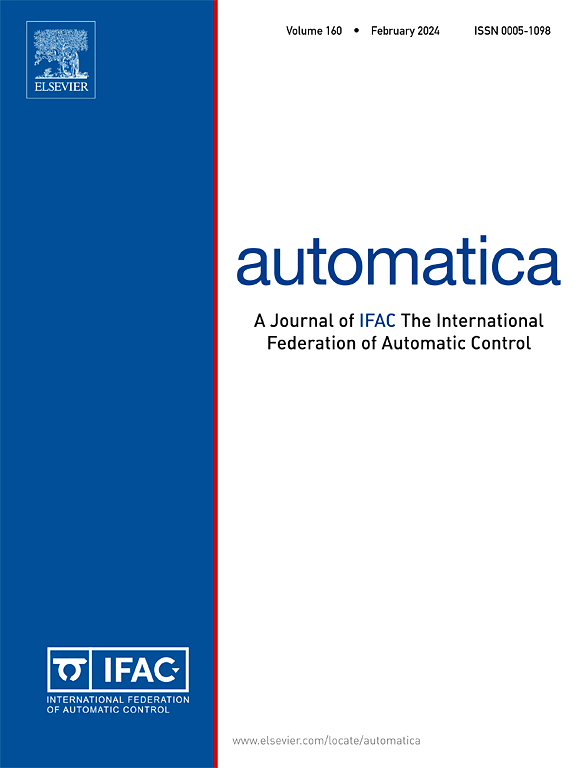时滞执行器反应扩散偏微分方程的输出反馈事件触发边界控制
IF 4.8
2区 计算机科学
Q1 AUTOMATION & CONTROL SYSTEMS
引用次数: 0
摘要
针对一类反应扩散偏微分方程,提出了一种输出反馈事件触发的时滞补偿边界控制方案,该方案在偏微分方程装置与偏微分方程执行器之间存在任意长的时滞。在将时间延迟视为传输PDE后,整个工厂配置变为ODE-PDE-PDE。结合PDE和ODE回溯设计,提出了一种三步回溯变换来构建连续实时控制律。设计了PDE观测器,利用边界测量来跟踪控制律所要求的PDE状态。然后,在对整个ODE-PDE-PDE系统进行评估的基础上,设计了动态事件触发机制,确定控制信号的更新次数。在由此产生的基于输出反馈事件的闭环系统中,发现了最小停留时间的严格正下界,该下界与初始条件无关。因此,可以保证不存在Zeno行为。此外,通过Lyapunov分析证明了所有信号的指数收敛于零,包括输运PDE状态的H1范数、反应扩散PDE状态的L2范数和观测器状态、执行器状态、事件触发机构的内部动态变量以及控制输入。数值仿真结果表明了该方法的有效性。本文章由计算机程序翻译,如有差异,请以英文原文为准。
Output-feedback event-triggered boundary control of reaction–diffusion PDEs with delayed actuator
We present an output-feedback event-triggered delay-compensated boundary control scheme for a class of reaction–diffusion PDEs under a delayed actuator, where an arbitrarily long time delay exists between the PDE plant and the ODE actuator. After treating the time delay as a transport PDE, the overall plant configuration becomes ODE-PDE-PDE. Combining the PDE and ODE backstepping designs, a three-step backstepping transformation is proposed to build the continuous-in-time control law. A PDE observer is designed to track the PDE states required in the control law using a boundary measurement. Then, a dynamic event-triggering mechanism is designed, based on the evaluation of the overall ODE-PDE-PDE system, to determine the updating times of the control signal. In the resulting output-feedback event-based closed-loop system, a strictly positive lower bound of the minimal dwell time is found, which is independent of initial conditions. As a result, the absence of a Zeno behavior is guaranteed. Besides, exponential convergence to zero of all signals is proved via Lyapunov analysis, including the norm of the transport PDE state, the norm of the reaction–diffusion PDE and observer states, the actuator states, the internal dynamic variable in the event-triggering mechanism, as well as the control input. The effectiveness of the proposed method is illustrated by numerical simulation.
求助全文
通过发布文献求助,成功后即可免费获取论文全文。
去求助
来源期刊

Automatica
工程技术-工程:电子与电气
CiteScore
10.70
自引率
7.80%
发文量
617
审稿时长
5 months
期刊介绍:
Automatica is a leading archival publication in the field of systems and control. The field encompasses today a broad set of areas and topics, and is thriving not only within itself but also in terms of its impact on other fields, such as communications, computers, biology, energy and economics. Since its inception in 1963, Automatica has kept abreast with the evolution of the field over the years, and has emerged as a leading publication driving the trends in the field.
After being founded in 1963, Automatica became a journal of the International Federation of Automatic Control (IFAC) in 1969. It features a characteristic blend of theoretical and applied papers of archival, lasting value, reporting cutting edge research results by authors across the globe. It features articles in distinct categories, including regular, brief and survey papers, technical communiqués, correspondence items, as well as reviews on published books of interest to the readership. It occasionally publishes special issues on emerging new topics or established mature topics of interest to a broad audience.
Automatica solicits original high-quality contributions in all the categories listed above, and in all areas of systems and control interpreted in a broad sense and evolving constantly. They may be submitted directly to a subject editor or to the Editor-in-Chief if not sure about the subject area. Editorial procedures in place assure careful, fair, and prompt handling of all submitted articles. Accepted papers appear in the journal in the shortest time feasible given production time constraints.
 求助内容:
求助内容: 应助结果提醒方式:
应助结果提醒方式:


